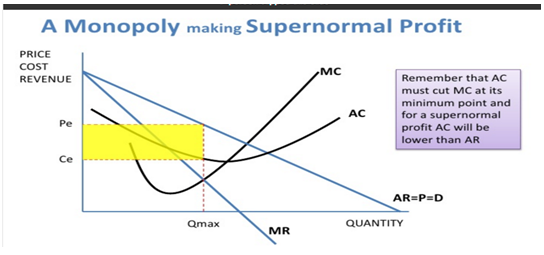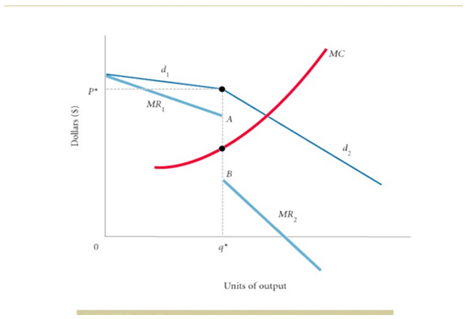Different market structures
Discuss about The Traditional Economic Theory of The Firm.
According to the Traditional economic theory, the objective the raison d’entre of the firm is to maximize profits. The statement implies that a firm enters into the market, whether there is free entry or not, to maximize its own profit. Profit maximization is the process, long run or short run determining the optimum level of output and price returning the highest possible profit to the firm. Along with many approaches in traditional economic theory, the total revenue and total cost approach that relies on the truth that profit is equal to revenue minus cost (Varian 2014). In addition, it focuses on the difference along with the marginal revenue-marginal cost aspect because total profit is reached at the maximum point when the marginal revenue equals the marginal cost.
Mainly there are four kinds of market structure prevails in an economy, namely- (i) Perfect Competition, (ii) Pure monopoly, (iii) Monopolistic competition and (iv) Oligopoly.
Firstly, in the perfectly competitive market, where the firms exhibit specific criterion such as, selling identical products, price taking specification, having small market share, having complete information about the goods and services that are sold with free entry and exit (Kirzner 2015). In perfect competition, profit is maximized when the price equals marginal revenue of the firm (Fussand McFadden2014).
In the monopoly, the profit maximization condition is when the price and marginal revenue equals the marginal cost i.e. MR=MC. The diagram below shows the price Pe is the price of the firm receives for every unit sold which is Average Revenue of the market and Ce being the Average cost of each unit. The diagram shows supernormal profit in monopoly, which is the sustainable long run profit for the market structure.

Figure 1: monopoly long run profit
For monopolistic competition, the company’s demand curve should end up being tangent to the average total cost curve to yield zero profit. This is the long run condition for monopolistically competitive market.

Figure 2: Monopolistic competition long run profit
In the oligopoly, the market structure is different. The kinked demand curve yielding long run profit is given the in diagram below.

Figure 3: oligopoly long run profit
The aspect of uncertainty is discussed with respect to the long-run profit maximization of a firm when it commits production before the price is set. The increase in demand uncertainty does not affect the equilibrium number or size of the firms if the firm is risk neutral. If the firm is risk averse, there will be a reduction in the equilibrium number of firms with an ambiguous effect on the sizes. In the equilibrium, if the firm is risk neutral, it operates at the capacity. Nevertheless, if the firm is risk averse, there will be excess capacity prevailing in the economy (Fudenbergand Tirole2013). The problem of uncertainty affects the long run profits of the firm if it is risk averse. In long term, the firm is affected by the price as the price level is always unpredictable. So whatever be the market structure, the risk averse firm will avoid investing in any kind of productions which will lead to a proper loss for the firm. The situation is quite different in case of the risk loving firms as they invest whatever be the future predicted price level.
Uncertainty
The principal agent problem is the situation when one party or agent agrees for working in favor of another party, who is the principal, by responding to some incentives. As people directly respond to incentives, the situation yields huge costs for the agents, causing a moral hazard (Okuguchiand Szidarovszky2012).
The principal agent problem includes everything from incentives regarding financial forms for avoidance of asymmetric information. The Principal-agent problem, also known as agency dilemma, happens in a situation while a person who is the agent is able making decisions on behalf of any other person or entity who is the principal. The dilemma persists, as the agent at times, gets motivated acting in his best level rather than that of the principal. This relationship of principal-agent is a proper useful tool to analyze the conditions regarding economics and political science. A very common example can be drawn as the relationship between corporate management (agent) and the shareholders (principal). The problem may arise in a greater manner when the two parties face information asymmetry. This is a situation when the principal is not able to ensure directly that the agent’s activity is at the principal’s highest level of interest. Here the problems of conflict of interest and Moral Hazard arise. The problem of moral hazard is the situation when one agent gets involved in any uncertain activity knowing about its protection against risk and the other party incurs the cost. In addition, the principal can be very much concerned about the exploitation possibility by the agent as he decides not to enter into the transaction of the both involved parties. This deviation from the interest of principal by the agent is named as “agency costs” (Sng2014).
Sales Maximization Theory (William Baumol):
The theory by Professor William Baumol on the Theory of Oligopoly incorporated a managerial theory of the company based on the maximization of the sales.
The theory exhibits the following assumptions:
The firm has a single period horizon, aiming at maximizing the sales revenue in long run subjected to the profit.
The firm's minimum level of profit is set competitively on the current value of market shares
The oligopolistic firm has a U-shaped cost curve and downward sloping demand curve with conventional total cost and total revenue curve.
The Baumol’s findings regarding the oligopoly firms reveal that they consider the sales maximization objectives. According to the economist, with the ownership separation and modem corporation control, managers seeking prestige and higher salaries to try expanding sales of the company even at the profit expenses (Baumoland Blinder2015).
The "Principal-Agent" Problem
The firm needs to exhibit minimum profits for financing the future expenditures. Minimum profits serve as the constraint on maximizing revenue. According to Baumol, revenue will be maximized only at an output when the demand is unit elastic. Therefore it differs from the traditional economic theory which talks about the invisible hand in market force and automation on equilibrating the optimums.
According to Williamson's utility maximization theory againost the profit maximization, also known as "managerial discretion theory," the managers and shareholders are two separate groups. The shareholders want to maximize the return on the investment as well as maximizing the profits. On the other hand, the managers are interested not only in their own fees but also in their staffs’ size and the expenses on them. Thus, the theory of Williamson relates to the maximization of the utility of the manager that is the function of staff expenditures and fees and discretionary funds (Sng2014). The assumptions of the model focus on: (i) imperfect competition in the markets, (ii) Divorce of management and ownership, (iii) minimum level of profit constraint existing for the company being able to pay dividends to the shareholders. The model differs from the traditional theory by the means of imperfectly competitive structure with the profit constraints.
According to Simon's theory, he compared the organizational behavior with the individual behavior. He proposed that as an individual, a firm aspires leveling to keep up with the needs and driving to achieve its goals. The firm has an aspiration for achieving a certain level of profits. The level of aspiration is based on the different goals and aims regarding production, prices, sales, profits, etc. (Varian2014). In the given situation, the firm faces three alternative situations as follows:
Firstly, the real achievement is lesser than the level of aspiration, when there is a big lag due to possible fluctuations in economic activities of the firm. Secondly, the achievement is greater than the level of achievement when the firm is quite satisfied with the performance. Thirdly, the achievement equates the level of aspiration when the outcome is also satisfactory. The theory differs from the traditional one in terms of targeting the profit level that the firm has an aspiration to reaching. The major objective is different and not reconcilable.
Conclusion:
The article critically analyzes the statement that is mentioned- “The traditional theory of the firm has long outlived its usefulness in explaining the raison d'entre of business organizations." The theories discussed the important factors affecting the firm's profit maximization conditions. The Simon's model is superior to the model by Williamson as it talks about individualism. On the other hand, in Williamson’s model, the managers are concerned with the utility maximization aspect. The Baumol’s model gives ambiguous ideas into this critical evaluation.
References:
Baumol, W. and Blinder, A., 2015. Microeconomics: Principles and Policy. Cengage Learning.
Fudenberg, D. and Tirole, J., 2013. Dynamic models of oligopoly.Taylor & Francis.
Fuss, M. and McFadden, D. eds., 2014. Production Economics: A Dual Approach to Theory and Applications: Applications of the Theory of Production (Vol. 2). Elsevier.
Kirzner, I.M., 2015. Competition and entrepreneurship.University of Chicago press.
McChesney, F.S., Reksulak, M. and Shughart, W.F., 2015. Competition Policy in Public Choice Perspective (Vol. 1, pp. 147-171).The Oxford Handbook of International Antitrust Economics.
Okuguchi, K. and Szidarovszky, F., 2012. The theory of oligopoly with multi-product firms.Springer Science & Business Media.
Sng, T.H., 2014. Size and dynastic decline: The principal-agent problem in late imperial China, 1700–1850. Explorations in Economic History, 54, pp.107-127.
Varian, H.R., 2014. Intermediate Microeconomics: A Modern Approach: Ninth International Student Edition. WW Norton & Company.
To export a reference to this article please select a referencing stye below:
My Assignment Help. (2017). The Traditional Economic Theory Of The Firm. Retrieved from https://myassignmenthelp.com/free-samples/the-traditional-economic-theory-of-the-firm.
"The Traditional Economic Theory Of The Firm." My Assignment Help, 2017, https://myassignmenthelp.com/free-samples/the-traditional-economic-theory-of-the-firm.
My Assignment Help (2017) The Traditional Economic Theory Of The Firm [Online]. Available from: https://myassignmenthelp.com/free-samples/the-traditional-economic-theory-of-the-firm
[Accessed 13 May 2025].
My Assignment Help. 'The Traditional Economic Theory Of The Firm' (My Assignment Help, 2017) <https://myassignmenthelp.com/free-samples/the-traditional-economic-theory-of-the-firm> accessed 13 May 2025.
My Assignment Help. The Traditional Economic Theory Of The Firm [Internet]. My Assignment Help. 2017 [cited 13 May 2025]. Available from: https://myassignmenthelp.com/free-samples/the-traditional-economic-theory-of-the-firm.
